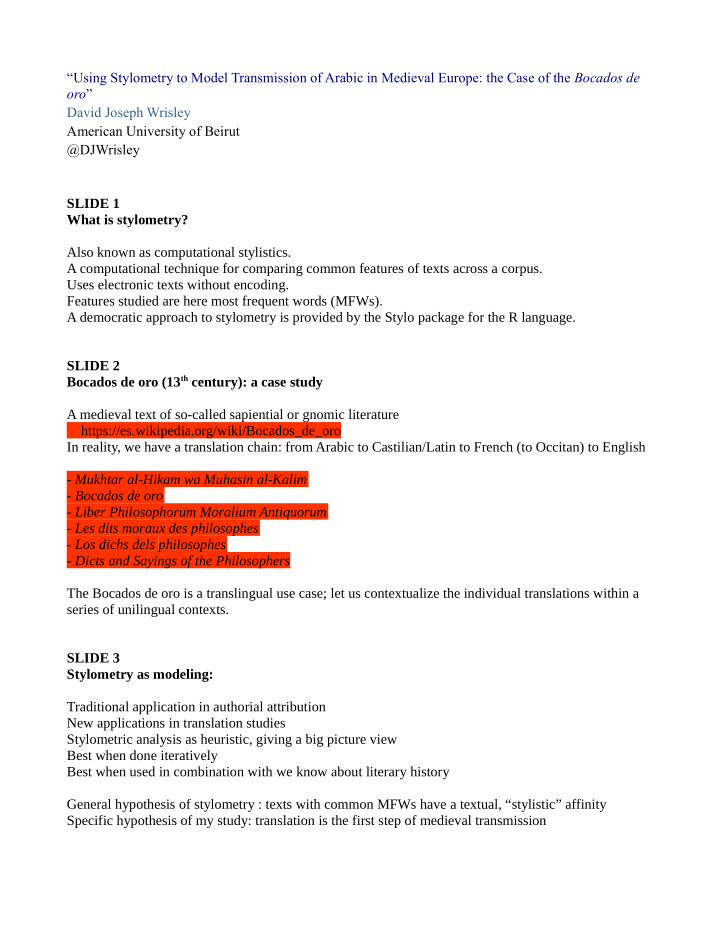



“Using Stylometry to Model Transmission of Arabic in Medieval Europe: the Case of the Bocados de oro ” David Joseph Wrisley American University of Beirut @DJWrisley SLIDE 1 What is stylometry? Also known as computational stylistics. A computational technique for comparing common features of texts across a corpus. Uses electronic texts without encoding. Features studied are here most frequent words (MFWs). A democratic approach to stylometry is provided by the Stylo package for the R language. SLIDE 2 Bocados de oro (13 th century): a case study A medieval text of so-called sapiential or gnomic literature https://es.wikipedia.org/wiki/Bocados_de_oro In reality, we have a translation chain: from Arabic to Castilian/Latin to French (to Occitan) to English - Mukhtar al-Hikam wa Muhasin al-Kalim - Bocados de oro - Liber Philosophorum Moralium Antiquorum - Les dits moraux des philosophes - Los dichs dels philosophes - Dicts and Sayings of the Philosophers The Bocados de oro is a translingual use case; let us contextualize the individual translations within a series of unilingual contexts. SLIDE 3 Stylometry as modeling: Traditional application in authorial attribution New applications in translation studies Stylometric analysis as heuristic, giving a big picture view Best when done iteratively Best when used in combination with we know about literary history General hypothesis of stylometry : texts with common MFWs have a textual, “stylistic” affinity Specific hypothesis of my study: translation is the first step of medieval transmission
Ernst Robert Curtius, Europäische Literatur und lateinisches Mittelalter (1948) In the preface to the English translation, Curtius (p.xxv) speaks of aerial photography at the time of World War Two that revolutionized archeology giving it a “bird's eye view”. Can stylometry do the same for literary history? SLIDE 4 Problems for medieval stylometry: Most stylometry is done on modern or pre-modern texts. With medieval texts, stylometry is done at the document level, not at the corpus level. -medieval texts are often anonymous -medieval texts come from “schools” of translation -we know very little about their emergence -literate society is multilingual -high degree of linguistic variance -traditional genres of literary history are often anachronistic SLIDE 5 Towards another definition of style -“bag of words” approach – focus on lexicon over syntax -most frequent words, not all “semantically significant” words -not intertextuality based on citation, not text re-use -“countable features of texts” -recommended reading: Herrman/van Dalen-Oskam/Schöch, “Revisiting Style: a Key Concept in Literary Studies” Journal of Literary Theory (2015) 9.1, 25-52. SLIDE 6 The Spanish case: -a corpus of 60+ mid thirteenth-century to late fourteenth-century texts -about 5,600,000 words -8 communities of texts, visualized with Gephi and exported via sigma.js Clusters: -topical: historical, legal, medical texts -regional languages: Navarro-Aragonese texts -single-author: Gonzalo de Berceo -“generic”: Mester de Clerecía texts -scientific
-sapiential Bocados de oro is not of the age of Alfonso X el Sabio, not central to literary history, and yet it is central to stylometry. Status quaestionis – Margaret , Deyermond, SLIDE 7 The Latin case: - corpus of 120+ Latin texts - more than 4 million words - spatio-temporal breadth of Latin - “bestselling” texts including (according the FAMA project) - LPMA not in the cluster of Arabic philosophical texts! - difficult of defining sapiential literature genre in Latin -proximity to Arabic translations and sapiential literature -stronger affinity with anonymous Liber Kalilae et Dimnae than with John of Capua→ possible Spanish origin, translation contemporary of Latin SLIDE 8 Findings -divisions in corpora (language, genre) do not align with stylometric analysis -proximity of sapiential literature to popular piety -no signal for texts of Arabic origin! -possible revision of the genre of sapiential literature? -revision of literary history, not a translation from Italy, but from Spain -empirical suggestion about important “stylists” of the type Bocados de oro: Juan Manuel (El Conde Lucanor), Juan Ruiz (Libro de Buen Amor)
Recommend
More recommend